Fasces › Fayum › Song of Everlasting Sorrow » Origins and History
Articles and Definitions › Contents
- Fasces › Ancient History
- Fayum › Ancient History
- Song of Everlasting Sorrow › Antique Origins
Ancient civilizations › Historical places, and their characters
Fasces › Ancient History
Definition and Origins
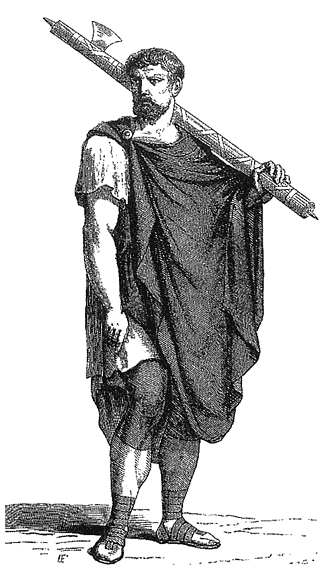
The fasces were a bundle of rods and a single axe which were carried as a symbol of magisterial and priestly authority in ancient Rome. They featured prominently in important administrative ceremonies and public processions such as triumphs.The symbol was adopted by later cultures to represent order and strength through unity, notably the fascist movement in Italyin the 20th century CE. The fasces are still visible today in many official contexts as a symbol of Republican principles, for example, in the United States' House of Representatives and on the cover of passports of French nationals.
EVOLUTION & FORM
The symbol of the fasces was probably borrowed by the Romans from the Etruscan kings, as evidenced by the excavation of a miniature iron version from a 7th-century BCE Etruscan tomb at Vetulonia. The Roman fasces were composed of a bundle of rods ( vergae ) which were made from either birch or elm wood. Rounded or rectangular in form the rods were typically 1.5 metres (5 ft.) in length. The rods were bound together with a single-headed axe and a slightly longer central staff using red leather straps. The axe was not only ceremonial but was used in the early Republic to execute those sentenced to death. For this reason, when the axe was removed from the bundle it was to signify that a citizen could launch an appeal ( provocatio ) against a death penalty decision.
FASCES WERE TYPICALLY CARRIED OVER THE LEFT SHOULDER OF MAGISTERIAL ATTENDANTS KNOWN AS LICTORS AS SYMBOLS OF JUDICIAL AUTHORITY.
FASCES & MAGISTRATES
Fasces were typically carried over the left shoulder of magisterial attendants known as lictors ( lictores ) as symbols of judicial authority. During official duty magistrates would be preceded by the lictors and the fasces which indicated to the public that a magistrate was coming and remind them of his authority to arrest or summon any person he saw fit. If one magistrate met another, the lictors of the less senior would lower their fasces in recognition of the greater standing of the other magistrate.When a magistrate died, he had the right to have a fasces representation on his tomb. Conversely, if a magistrate committed any wrong-doing, not only was he obliged to resign but his fasces were ceremoniously broken to symbolise his disgrace and loss of authority.
WIDENING THE FUNCTION OF FASCES
During the Republic consuls (chief magistrate), and later proconsuls, also had their personal lictors bearing the fasces. Then only when the consul was outside Rome did the fasces have the axe element as this came to signify military authority. During the triumph of a Roman military commander the fasces were carried by lictors in the procession and decorated with laurel leaves. The emperor also decorated his fasces in the same way. At the other end of the scale, municipal magistrates may have had, according to Cicero, a lesser version, the bacilli, which had only two rods and no axe.

Roman Coin Depicting Lictors Carrying Fasces
Over time the use of lictors and fasces further widened to represent the authority of other officials and religious posts such as praetors (one step down from consuls), propraetors, the wife of the emperor in her role as imperial cult priestess, and the Vestal Virgins. A ranking system developed where the more senior positons had the right to bear a greater number of fasces.In the Republic magistri equitum (cavalry commanders) and praetors had six, proconsuls and consuls had 12, and dictators had 24. In the Principate, senatorial governors had a number indicating their experience, imperial legates (senators who were also military commanders) had five, and emperors had 12, with Augustus perhaps having 24 fasces whenever he was outside Rome.
Fayum › Ancient History
Definition and Origins
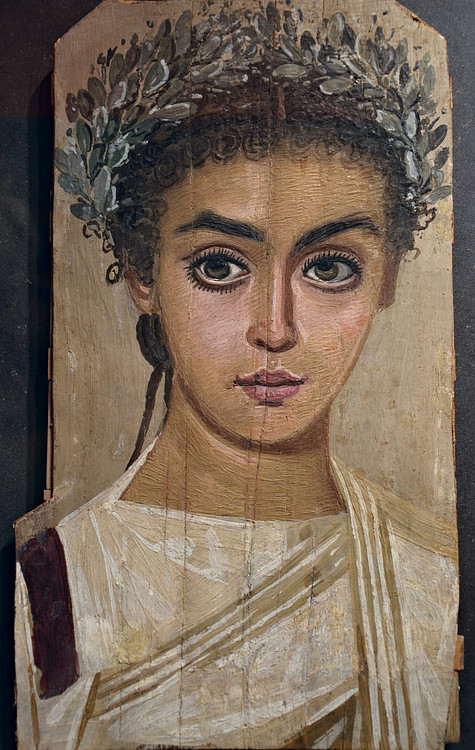
The Faiyum (also given as Fayoum, Fayum, and Faiyum Oasis) was a region of ancient Egypt known for its fertility and the abundance of plant and animal life. Located 62 miles (100 kilometers) south of Memphis (modern Cairo), the Faiyum was once an arid desert basin which became a lush oasis when a branch of the Nile River silted up and diverted water to it. The basin filled, attracting wildlife and encouraging plant growth, which then drew human beings to the area at some point prior to c. 7200 BCE.
In the present day, Faiyum refers to the modern city of Medinet el-Faiyum but, in antiquity, designated the entire area which supported a number of large and quite prosperous villages and cities such as Shedet (better known as Crocodilopolis), Karanis, Hawara, and Kahun, among others. The name derives from the ancient Egyptian word Pa-yuum or Pa-yom meaning “the Lake” or “the Sea” and refers to Lake Moeris, created by Amenemhat I (c.1991-1962 BCE) of the 12th Dynasty during the Middle Kingdom (2040-1782 BCE) when the kings of the 12th Dynasty, in particular, paid special attention to it.
The Middle Kingdom of ancient Egypt is considered a “golden age” in which the culture produced some of its finest works and the Faiyum benefited from the stable rule of the 12th Dynasty as much as any other region and, in many aspects, more so.Although some modern writers and commentators connect Pa-yom with the city of Pithom mentioned in the Book of Exodus 1:11, this claim is untenable; Pa-yom referenced an area, not a city, and the two words are not synonymous.
THE REGION IS BEST KNOWN TODAY FOR THE SO-CALLED FAIYUM PORTRAITS, A COLLECTION OF BEAUTIFULLY RENDERED MUMMY MASKS.
The region was most prosperous during the Middle Kingdom but declined after the fall of the New Kingdom (c. 1570-c.1069 BCE). It experienced a revival during the Ptolemaic Dynasty (323-30 BCE) and the Roman Period (30 BCE-646 CE) after which it was neglected and declined steadily. It is best known today for the so-called Faiyum Portraits, a collection of beautifully rendered mummy masks created during these later periods and unearthed c.1898-1899 CE by the Egyptologist Flinders Petrie.
EARLY HABITATION
Initially a lifeless basin, the Faiyum was transformed into a fertile garden by the natural silting of the Nile which diverted a significant branch of freshwater in its direction. The flow of the water carried with it the rich soil of the Nile River bed which settled in and around the newly-created lake and sprouted vegetation along its banks. The water and plant life attracted animals who made it their home and these then brought others in search of prey or simply creatures seeking water in an arid region.

Faiyum
This branch of the Nile would eventually be named Bahr Yusef (“Joseph's River”) in honor of the prophet Joseph in the Quran (the biblical counterpart of the Joseph from the Book of Genesis) and still exists in the present day as a canal. The first canal (known as Mer-Wer, “Great Canal”) was built during the Middle Kingdom. These developments came much later, however, after people arrived and felt the need to name objects and items around them; before it became a canal or had a name it was just a naturally occurring offshoot of the Nile. This waterway, and the fertile environment for wildlife it created, eventually drew human beings to the area.
Evidence of human habitation in the Sahara Desert region dates back to c. 8000 BCE and these people migrated toward the Nile River Valley. According to Egyptologist David P. Silverman, “traces of the earliest undisputed farming community in Egypt have been discovered at Merimde Beni Salama, a site on the western fringe of the Delta dating to c. 4750 BCE” (58). This date was accepted by the scholarly community for decades until, in 2007 CE, the ruins of an older farming community was discovered in the Faiyum dating to c. 5200 BCE and pottery has also been found dating to 5500 BCE. It should be noted that these dates relate only to established agrarian communities, not to human habitation of the Faiyum region which dates to c.7200 BCE.
The Faiyum c. 5000 BCE was a lush paradise in which the people must have lived fairly comfortable lives. There was an abundance of food and water, shade from the sun through the tall fronds of many trees, and fish and wildlife to supplement their diet. At some point around 4000 BCE, however, a drought seems to have changed these ideal living conditions and many people migrated toward the Nile River Valley and left the Faiyum basin relatively deserted. These people would form the communities which grew into the great Egyptian cities of antiquity.
PEAK PROSPERITY
In the Early Dynastic Period (c. 3150-c.2613 BCE) the region seems to have been largely neglected by these settlements, though it was still inhabited, but in the period of the Old Kingdom (c.2613-2181 BCE) the Faiyum was again a lush and wild paradise and became the preferred locale for hunting of wild animals by the Egyptian nobility. At this time, the Faiyum was known as Ta-She (“Land of the Lakes” or “Land of the Southern Lakes”) by the kings of Memphis who recorded their expeditions there.
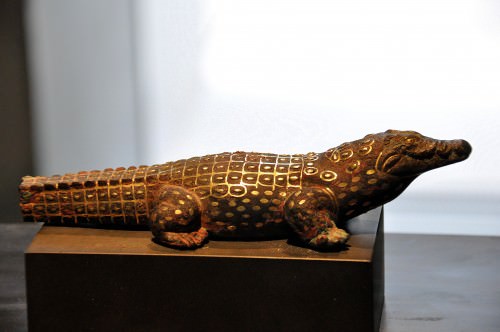
Crocodile Statue from Ancient Egypt
It was a region primarily inhabited by wildlife (though there were still sporadic villages there) and numerous plants, including papyrus, grew in abundance. This was noted by the hunters who soon developed a system to harvest these plants for a number of different purposes. Papyrus is well known as the “paper” of ancient Egypt but was also used for making small fishing boats, rope, clothing, children's toys, amulets, baskets, mats, window shades, as a food source, and for many other items.
In the early Middle Kingdom, Amenemhat I ordered the construction of canal work along the Bahr Yusef which flooded the Faiyum and created the great Lake Moeris. This lake could be the one referenced in the New Kingdom literary work known as Setna II in which a great Egyptian sage defeats a Nubian sorcerer by transporting his diabolical creation to the center of a large lake. Amenemhat I's successor, Senusret I (c.1971-1926 BCE), seems to have felt the lake was too great a luxury and wasted prime agricultural land and so ordered a series of canals built to drain it.
Senusret I's canal system operated off a series of hydraulics which moved the water out of the Faiyum basin to other locales while still preserving a body of water there. The result was a reclamation of fertile land, the transport of water to areas in need of irrigation, and a continuation of the eco-system the lake sustained. Senusret I was succeeded by Amenemhat II (c.1929-1895 BCE) about whose reign little is known but this king's successor, Senusret II (c.1897-1878 BCE) continued Senusret I's policies in the Faiyum and maintained the canal system.
Senusret II was succeeded by his son Senusret III (c.1878-1860 BCE), considered the greatest king of the already impressive 12th Dynasty. Senusret III is best known for his successive victories over the Nubians and the redistricting of Egypt to cut the power of the district governors (nomarchs) but these achievements were only two aspects of a reign which epitomized the Egyptian cultural value of ma'at (harmony and balance) and elevated the Middle Kingdom to its greatest heights. Senusret III's reign marked the peak of prosperity for the Middle Kingdom generally and the Faiyum specifically.
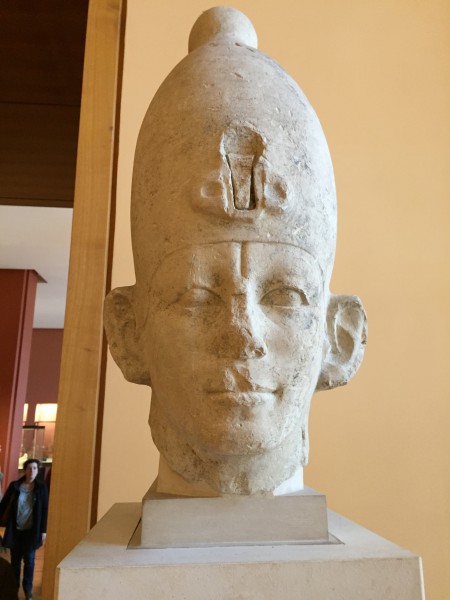
Senusret III
Cities in the Faiyum, such as Kahun (founded by Senusret II) expanded and became more prosperous under Senusret III. The city of Shedet, which was the capital of Faiyum region from the Old Kingdom onward, also thrived as did the others. The rich produce of the region, which reportedly was better tasting than any other, resulted in a high demand and lucrative trade with other regions in Egypt and also abroad.
Senusret III's successor was Amenemhat III (c.1860-1815 BCE) who devoted significant attention to the region. He returned to the policies of Senusret I and installed retaining walls, dikes, and canals to lower the level of Lake Moeris further and provide more arable land. He built the famous Labyrinth as part of his temple complex at Hawara which Herodotus would later record as more impressive than any of the Seven Wonders of the Ancient World. Amenemhat III also erected a number of other remarkable monuments throughout the area, as the kings of the 12th Dynasty had done before him, and instituted policies which stimulated the economy further and encouraged trade.
By this time, of course, the Faiyum was no longer roaming with wild animals or as lush with verdant plant life. As the region became more prosperous, it naturally became more popular; the villages grew into cities and the cities expanded and supported suburbs which grew up on their outskirts and expanded further. Building an addition to one's house, or erecting new homes, was as simple as measuring out a plot of land, making as many mud bricks as were required, and setting them in place. There were no zoning laws and one could build where one pleased as long as no one else objected.
THE GREAT WEALTH OF THE FAIYUM, AS WELL AS ITS NATURAL BEAUTY, ATTRACTED MORE & MORE PEOPLE TO THE REGION EVEN THOUGH THE TAX WAS HIGHER THAN ANYWHERE ELSE IN THE AREA.
There were upper-class homes which featured wooden beams, windows, and wooden doors but the simplest of homes could be constructed for a modest sum and relatively quickly. In the same way that people today ask friends and family to help them move or complete home improvements, those in the ancient Faiyum would host a party where guests would help them make and later assemble mud bricks to build a home or addition. The great wealth of the Faiyum, as well as its natural beauty, attracted more and more people to the region even though the tax the government levied on these citizens was higher than anywhere else in the area.
This was the state of the Faiyum region at the beginning of the 13th Dynasty of the Middle Kingdom. The 13th dynasty lacked the power and focus of the 12th and slowly degenerated with each successive ruler. Towards the end, the nobility was focused far more on their own pleasure and personal dramas than the good of the country and allowed the Hyksos, a foreign people who had established themselves at Avaris in the Delta, to gain significant control over Lower Egypt. These developments led to the steady loss of power of the central government which finally fell, ushering in the era known as the Second Intermediate Period (c.1782-c.1570 BCE).
Little is recorded of the Faiyum during this time or in the New Kingdom which followed it. No new monuments were built and maintenance of the canals seems to have been neglected. By the beginning of the Ptolemaic Dynasty, the great canals, hydraulic works, walls, and monuments had suffered from years of inattention and the Faiyum was only a pale shadow of its former self.
THE GRECO-ROMAN PERIOD & FAIYUM PORTRAITS
The Third Intermediate Period (c.1069-525 BCE), which followed the New Kingdom saw an Egypt divided in rule between Tanis and Thebes, rulers from Libya and Nubia, and was punctuated at the end by the Persian Invasion. The Late Period (525-332 BCE) was an era in which the country traded hands between the Persians and Egyptians until the Persians conquered the country. Alexander the Great took Egypt from the Persians in 332 BCE and, after his death, it was claimed by one of his generals, Ptolemy I Soter (323-285 BCE), who founded the Ptolemaic Dynasty.
Ptolemy I and his immediate successor, Ptolemy II Philadelphus (285-246 BCE) devoted significant attention to the Faiyum, repairing and renovating the monuments, temples, canals, and administrative buildings which had fallen into decay. Ptolemy I drained Lake Moeris further for more arable land and Ptolemy II allocated lots of this fertile region to Greek and Macedonian veterans who improved upon it.
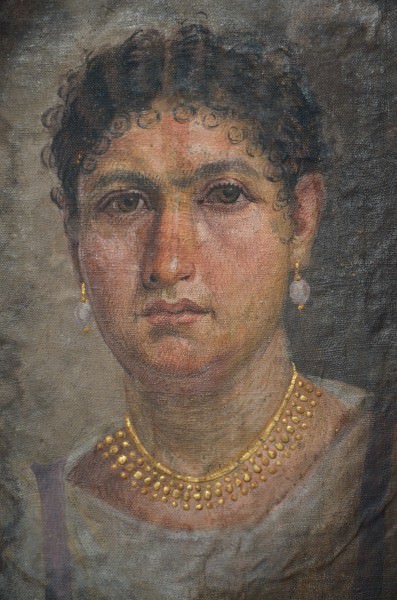
Mummy portrait of Lady Aline
Since the conquest of Alexander the Great in 332 BCE, life in the Faiyum had improved dramatically. Although evidence of this prosperity is seen in a number of examples, the best and most famous is the Faiyum Portraits. These are paintings of the elite members of the community produced on wooden panels and placed on their mummies.
When they were first discovered by Flinders Petrie in the late 19th century CE it was thought they were painted from life and the subjects kept them on the walls of their homes until their deaths. It has since been established, however, that these paintings were done after the subjects' death. The incredible vitality of the paintings, especially the expressive eyes, makes it easy to understand why Flinders Petrie believed the subjects had to have been alive when the paintings were done.
These works are detailed renderings which accurately depict the clothing, jewelry, hair styles, and important personal objects of people at the time. The obvious wealth of the subjects reflects the prosperity of the region which is also exemplified simply by the existence of the paintings which are high-quality works created by an affluent and stable society. Egyptologist HelenStrudwick writes:
The Faiyum Portraits are truly original pieces of art, representing a synthesis of the naturalistic Classical style of portraiture with the ancient Egyptian concept of death as a gateway to a continuing existence in the afterlife. The portraits have provided Egyptologists with a wealth of information regarding high-status members of Greco-Roman society in Egypt – in particular their clothing, adornment, and physical characteristics – as well as being masterpieces of art in their own right. (336)
The paintings reflect the attention which was once again lavished on the Faiyum during this time. The first two rulers of the Ptolemaic Dynasty drew on inspiration from Egypt's past and worked to create a multi-cultural society which welcomed diversity and encouraged culture and intellectual pursuits. It was under these rulers that the Library at Alexandria, the Serapeum, and the great lighthouse at Alexandria were all created. Their successors were less competent however and, by the time of Cleopatra VII (c.69-30 BCE) the grandeur of Egypt had waned considerably.
DECLINE OF THE FAIYUM
After Cleopatra ’s death, the country was annexed by Rome under Augustus Caesar (27 BCE-14 CE). By this time, after the years of neglect during the later Ptolemaic Dynasty, the Faiyum had deteriorated to the point where the canals and drainage pipes were blocked and unusable. Augustus ordered extensive repairs to the area on every level and brought the Faiyum back to life. Throughout the early years of the Roman Period the area experienced something of its former prosperity since it was still such fertile farm land and Egypt was considered Rome's breadbasket, furnishing the empire with grain.
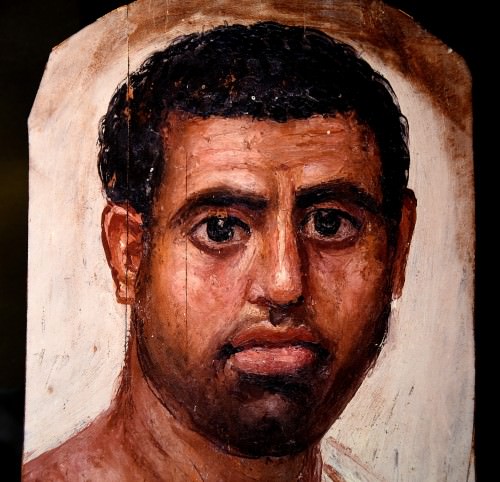
Mummy Portrait of a Man from Fayum
The Faiyum continued to prosper as long as the empire was stable and expanding on a steady, regular, basis but, when it began to decline, its provinces followed suit. The Faiyum's population began declining in the 2nd century CE and a deadly plague devastated the population further. By the beginning of the 3rd century CE the population had been reduced to below 10 percent of the previous century's occupants.
The fertile valley, by this time, had been overused and much of the land had been developed to the point where there was no longer any wild game to hunt and no new wildlife came to the area. The papyrus plants, which had once been so plentiful, had been harvested to near extinction as had the flowers and other fauna which had once attracted the people to the region in the first place.
Although the Faiyum continued on throughout the Roman Period until the Arab Invasion of the 7th century CE, and served as the center of Egyptian resistance to the Arabs, it would never return to its former grandeur and prosperity. Under Arab rule it would certainly experience eras of abundant crops and prosperous trade, and the population again expanded, but the natural resources of the region had been depleted – and would continue to be as more and more was asked of the land – until the valley again resembled the arid basin it had been millennia before.
In the present day, the area is again a rich agricultural region due to ecological preservation efforts and improvements in land husbandry. A number of impressive ancient Egyptian ruins have also been preserved throughout the region, such as the pyramid of Amenemhat III at Hawara, but even though the area is relatively close to Cairo it does not receive many tourists.The people of the Faiyum today live largely as their ancestors did thousands of years ago as they farm the land with essentially the same kinds of tools, and in the same way, as the people did long ago in the golden age of the Middle Kingdom.
Song of Everlasting Sorrow › Antique Origins
Ancient Civilizations
The Song of Everlasting Sorrow (also known as Song of Everlasting Regret ) is a narrative poem of the Tang Dynasty (618-907 CE) inspired by the love affair between Xuanzong, the seventh emperor of the dynasty, and his consort Lady Yang. It was written by the Chinese poet Bai Juyi (772-846 CE) and is among his most popular. It was an instant success when Bai published it in 806 CE and has been regularly memorized by Chinese students in the centuries since then. The poem is a romanticized version of the real-life affair of Xuanzong and Lady Yang but is set further back in time during the Han Dynasty(206 BCE - 220 CE). Bai Juyi is known for his highly romantic poetry which uses vivid but also very simple imagery because he wanted everyone to be able to enjoy his work without having to struggle to find its meaning. Bai Juyi wrote over 2,800 poems on many different subjects and these remain widely read in China and are also popular in Japan. The Song of Everlasting Sorrow became his most popular, though, because of its themes of deep romantic love, loss, and the image of love lasting beyond death.
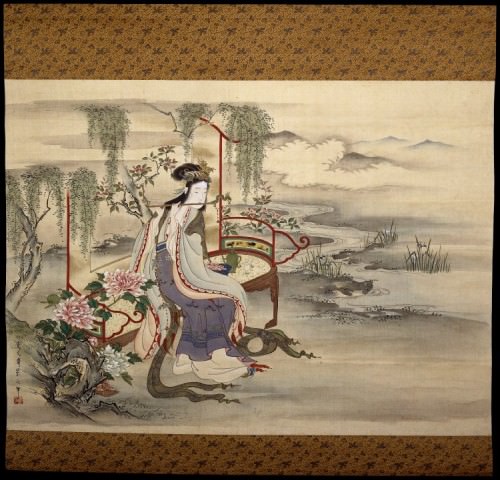
Lady Yang
THE STORY IN HISTORY
Xuanzong ruled as emperor from 712-756 CE and is considered one of the best monarchs in China's history for his early policies. He followed the example of his two predecessors, Taizong (626-649 CE) and the empress Wu Zetian (683-704 CE) in reforming the laws, streamlining the bureaucracy, and providing for the people. Under Xuanzong's early reign, China achieved unprecedented wealth and prosperity to become the most affluent country in the world at that time.
Around 734 CE, though, Xuanzong grew tired of his responsibilities and began to rely more on his wife to make his decisions.She suggested he appoint a family friend named Li-Linfu as chancellor. When his wife died, Xuanzong became more withdrawn from public affairs and trusted the running of the government more and more to Li-Linfu. He had over 3,000 beautiful young women brought to the palace to entertain him and kept them there against their will. Even with all these women under his control, Xuanzong was still unhappy until, in 741 CE, he fell in love with the young wife of his son, a woman named Yang Guifei. Xuanzong had Yang move into the palace with the rest of the women but only spent time with her. She left her husband and became the emperor's consort. He neglected his duties as emperor for this love affair and agreed to anything Lady Yang asked. She began with small requests, which he granted, and these grew into larger demands until she got him to promote members of her family to important positions even though these people could not do the jobs.
All of the important reforms and progress Xuanzong had made started to unravel as the members of Yang's family abused their positions and neglected their duties. At the same time, the policy of using foreign nationals in the army (which had grown out of Xuanzong's military reforms) led to the promotion of some of these men to very high positions of command. Li-Linfu exploited this situation to place men loyal to him in command of the army at the same time he was accepting bribes from Yang's family to appoint them to comfortable bureaucratic posts. The former prosperity of the country began to decline as the people in authority spent more time enjoying themselves than taking care of their responsibilities.
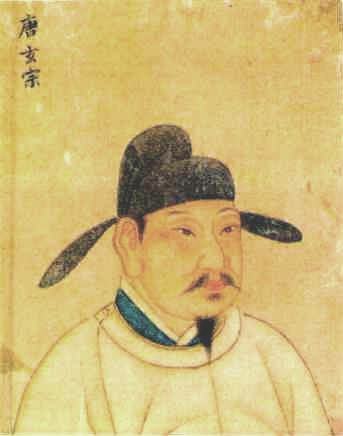
Emperor Xuanzong
A half-Sogdian/half-Turk general named An Lushan, who was a friend of Lady Yang's, saw the Yang family's abuses as a sign that Xuanzong was no longer fit to rule. An Lushan commanded the best troops in the Chinese army and felt he had a duty to take action and lead these men to restore a proper government; so he mounted a rebellion against the ruling house in 755 CE.He overthrew Xuanzong and declared himself emperor. He was challenged by the Tang forces and his rebellion crushed but he had started something which could not be stopped. The country would be torn apart between the years 755-763 CE and close to 36 million people would die.
Xuanzong fled the capital in 755 CE with Lady Yang and her family. The men of the military escort who accompanied them blamed Yang for the troubles and murdered her family en route. The commanders of the army then demanded that Lady Yang be killed also. Xuanzong refused, but the men would not back down and he had no choice but to comply. He admitted he had allowed himself to be seduced away from his duties and consented that Lady Yang should be strangled. Xuanzong no longer wanted to rule and was heartsick over the death of Lady Yang. He abdicated in favor of his son Suzong (756-762 CE) and retired from public life. Suzong led the Tang armies into battle but could not defeat An Lushan no matter how he tried. Suzong and Xuanzong died of disease within two weeks of each other in 762 CE, and he was succeeded by Daizong (762-779 CE) who finally restored order.
THE STORY IN THE POEM
In the poem, an emperor of the Han Dynasty falls in love with a beautiful young girl who has no experience of the world. The poem states that she was "Raised in the inner chamber, unseen by anybody". She is so beautiful that "if she turned her head and smiled she cast a deep spell/Beauties of Six Palaces vanished into nothing". The emperor selects her as a concubine and becomes so entranced by her that he forgets his responsibilities. The poem states, "The emperor neglected the world from that moment". The two lovers enjoy every minute they can together until war breaks out and the emperor is expected to lead his troops in battle. He cannot leave her alone and brings her with him to the war. The men see that the emperor is distracted and they are going to be defeated and killed unless he comes to his senses. They demand that the lady be killed, and the emperor has no choice but to allow it. After her death, the emperor regains his focus and leads his army to victory. He returns to his palace where he reflects on all the happy times he had with his lover and misses her.

Lady Yang Guifei
The emperor has a Taoist priest contact the land of the dead so he can speak to his lover again. The poem describes the priest searching everywhere for her and finally waking her up where she slept on a magic island in the afterlife. She has moved on, though, and no longer has anything to do with earthly desires. The poem says how "when she turned her face to look back earthwards" she saw only "mist and dust clouds". She thanks the emperor's messenger for coming and asks him to relay a message; then she breaks her golden hairpin in half and gives one to him along with a piece of her lacquer box. The spirit of the lady asks the messenger to give these gifts to his emperor and tell him that she still loves him and "Our spirits belong together, like these precious fragments" and how "sometime, in earth or heaven, we shall meet again". She references the myth of Niu Lang and Zhi Nu, the god and goddess of love, who can only meet with each other on the seventh night of the seventh month each year in the night sky (represented by the star Vega, who is Zhi Nu, and the star Altair, Niu Lang, which are on opposite sides of the Milky Way except for one time every year - on the seventh night of the seventh month). The poem ends with the lines "Earth fades, Heaven fades, at the end of days. But Everlasting Sorrow endures always."
THE POEM'S SIGNIFICANCE
The two most famous poets of the Tang Dynasty were Li Po (701-762 CE) and Du Fu (712-770 CE), who were both praised for their vivid imagery and clever allusions in depicting everyday scenes. Xuanzong was a Taoist who decreed Taoism the national religion but Confucian principles of propriety still governed people's behavior and attitudes, and art was expected to reflect Confucian principles, which these poets did. Poetry was expected to express reality, even if that reality was heightened or the details were not exactly true. Li Po, for example, wrote a poem about a party where the narrator praises "a drinking bout of at least three hundred cups" and says "All I want is to be forever drunk, never sober", and these lines do not reflect Confucian values. Li Po was praised, though, because the poem accurately reflects the attitudes of someone drinking at a party.
SONG OF EVERLASTING SORROW TOUCHES ON THEMES WHICH PEOPLE WILL ALWAYS RELATE TO SUCH AS LOVE, SACRIFICE, DEATH, AND THE HOPE THAT ONE WILL BE REUNITED ONE DAY WITH THOSE ONE HAS LOST.
Bai Juyi's poetry was criticized because it was often considered inappropriate and did not reflect reality or Confucian values.His work was considered lower class because it was more accessible in content and imagery than poets like Li Po or Du Fu.Song of Everlasting Sorrow was especially criticized by Confucian scholars for warping people's impression of what really happened to Lady Yang and how her death came about. Literary critics condemned the poem's sensuality and romanticism and claimed that Bai was lowering the standards of his art by writing for the masses. The masses loved the poem, though, and it became a best-seller when Bai published it. Fans of Bai's work did not care about the judgments of scholars or critics;they just responded to the beauty of the verse and the story of the tragic love affair. It elevated Lady Yang from her role in history as the woman who brought down the Tang Dynasty to the girl who allowed herself to be sacrificed for the greater good of the country. The conclusion of the poem, when the lady speaks to the messenger from the afterlife, offered consolation to those who had lost people they loved and this made the work very appealing.
The poem also elevated Lady Yang to a mythical level as one of The Four Beauties of China. The Four Beauties are four women whose actions dramatically affected the fate of the nation. They are Xi Shi of the Spring and Autumn Period; Wang Zhaojun of the Han Dynasty; Diaochan, a fictional character from the book Romance of the Three Kingdoms ; and Yang Guifei.Some lists include a Fifth Beauty, Consort Yu (also known as Lady Yu) famous as the concubine of Xiang-Yu who sacrificed herself for her lover at the Battle of Gaixia in 202 BCE, while other lists replace Diaochan with Consort Yu. The theme of the beautiful woman who dies to save her lover or destroys a man of promise (or, often, both) was very popular in ancient China and continues to be in the present day. Bai Juyi's version of Lady Yang's death and Xuanzong's grief has probably inspired many people to write similar stories but the best-known work to draw upon it is Lady Murasaki's The Tale of Genji, a classical work of Japanese literature published in 1008 CE and still widely read today. This is not surprising since Song of Everlasting Sorrow touches on themes which people will always relate to such as love, sacrifice, death, and the hope that one will be reunited one day with those one has lost.
LICENSE:
Article based on information obtained from these sources:with permission from the Website Ancient History Encyclopedia
Content is available under License Creative Commons: Attribution-NonCommercial-ShareAlike 3.0 Unported. CC-BY-NC-SA License